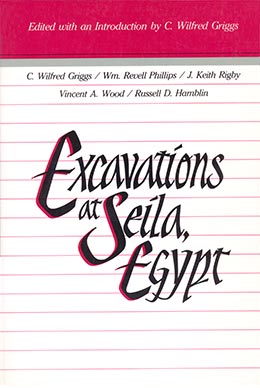Introduction
C. Wilfred Griggs
Introduction to Excavations at Seila, Egypt, ed. C. Wilfred Griggs, (Provo, Utah: Religious Studies Center, Brigham Young University, 1988), xi–xiii.
Few academic disciplines conjure up as many romantic scenes and expectations as archaeology, and no country has had a more spellbinding effect on western civilization during the past two and one half millennia than Egypt. From the fifth century B.C, when the Greek historian Herodotus devoted one book of his history to Egypt (although the subject of his work was the Greek-Persian wars), to’ the discovery in the twentieth century of the tomb and treasures of Tutankhamen, fascination with the ancient civilization of the Nile valley has never ceased. Less well-known than Herodotus or Howard Carter, but not less important in the reconstruction of the history of Egypt, are the ongoing historical and archaeological efforts of teams of scholars from around the world. The glamor, danger, and excitement of such work are far removed from the “Hollywood” depictions in recent movie films, but one cannot overlook the expectation and thrill of discovering an artifact which sheds greater understanding on the life, religion, livelihood, and accomplishments of people who lived thousands of years ago. No less exciting are the clues from the earth itself relating to the formation and geological changes which a site has undergone over much greater periods of time. The collected essays in this volume deal with both the geology and history of an unusually interesting site in Egypt, located on the eastern edge of the Fayum depression, or due west from the Meidum pyramid if one is taking his bearings from the Nile valley.
Since the late 1970’s, Professor Leonard Lesko, then the senior Egyptologist at the University of California, Berkeley, and Professor C. Wilfred Griggs of Brigham Young University (a former student of Dr. Lesko) had discussed the possibility of a joint excavation in Egypt. The opportunity to excavate near the village of Seila, an archaeological site which contains two large cemeteries and a small Old Kingdom pyramid, arose during the display of the Tutankhamen treasures in San Francisco. Dr. Lesko became the project director, Dr. Griggs was the field director, and the project was jointly sponsored by UC Berkeley and BYU. The first season, from January to March, 1981, was divided between the north cemetery, a site named Fag el-Gamous, and the Seila pyramid. A few squares were excavated in the cemetery-not all completely—and the pyramid was partially cleared, with work at both areas of the site showing promise for future seasons.
Altered circumstances, including Dr. Lesko’s appointment to an endowed chair of Egyptology at Brown University, led the Egyptian Antiquities Organization (EAO) to invite Dr. Griggs to become the project director of the Seila excavation, and Brigham Young University became the sole sponsoring institution. A small team comprised of Wilfred Griggs, Revell Phillips, and George Homsey went to Egypt in 1983 to survey the site for detailed mapping and to make a preliminary geological analysis. This was followed by a full-scale excavation at the north cemetery in January-March, 1984, with the same staff members plus Mrs. LaRue Phillips, pathologists Dr. Vincent Wood, Dr. Douglas Wyler, and Dr. Eugene Pocock. Two students, Russell Hamblin, a graduate student in the Geology Department at BYU, and Morgan Tanner, an undergraduate archaeology major, were also members of the 1984 team. Professor Keith Rigby of the BYU Geology Department was on site for a brief time, in part to advise Russ Hamblin in his Master’s thesis on the geology of the site. The essays in this collection are there ports of activities carried out in the 1984 season. Future seasons will undoubtedly provide data which will expand, limit, or modify the conclusions in these essays, but the participants feel the necessity to make available to interested readers the data of “progressive reports,” rather than to wait for a single, final publication.
The inspector assigned by the EAO to work on the site with the team in 1984 was Akram Edward Eshat, and the success of the season was enhanced by his enthusiastic and capable assistance. The team also benefited from the support of Mr. Ali el-Bazidi, chief inspector for the Fayum, as well as Mr. Mostafa el-Zairy, the area director for the general region. Mr. Sabri Gabbour, director of the Kom Aushim Museum, assisted in making local arrangements for the staff, both for living quarters and numerous other matters. Dr. Ali el-Kholy, director-general of Antiquities for Middle Egypt, gave inestimable help to the project, providing guidance and counsel in many ways. Dr. Ahmed Kadry, director of the EAO, also provided the necessary leadership to see that contracts, security clearances, and like necessities were prepared and in order so that the project could proceed. There were others, too numerous to mention here, whose dedication to the recovery and restoration of Egyptian antiquities is a labor of love, to whom gratitude for the success of the 1984 excavation season is due. It is a pleasure to acknowledge the ongoing friendship and assistance of Dr. Fattah Sabbahy, senior official in the EAO, in the continuation of this project. Grateful acknowledgement is also extended to BYU and its administrators, especially Dr. Jae R. Ballif, Provost and Academic Vice President, for unfailing and unstinting support to this project.
